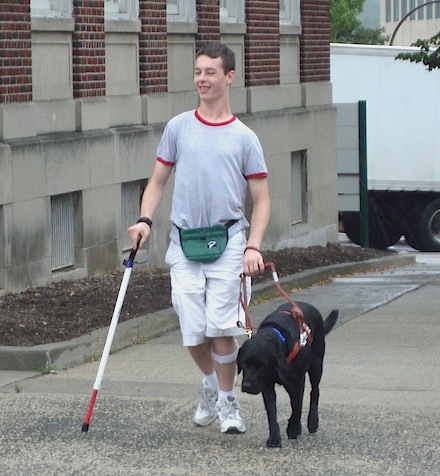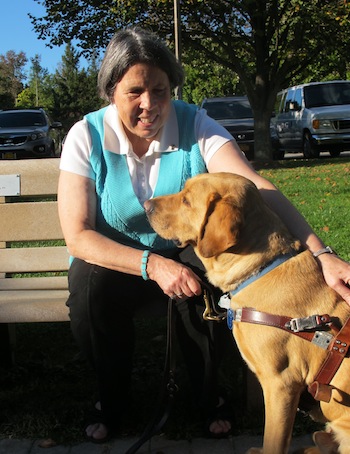Spotlight On: Guide Dogs
Guide dogs have an important job to do for their human companions. We take a closer look at how they improve our quality of life.

Amy Dixon was a hard-working college student when her vision began flashing and strobing.
“It’s like a short-circuiting television that’s only getting static,” she explains. Diagnosed with a rare autoimmune disorder combined with an eye disease, she went on steroids and eventually chemotherapy, but over the years she gradually lost most of her sight.
A career as a wine specialist required frequent trips to European vineyards, which became difficult as her vision decreased. “I was terrified to be in crowds because I couldn’t walk without knocking over people. I couldn’t see anything below waist level,” she says. So Amy learned to use a white cane.
“I hated the cane because everybody felt sorry for me. I’m a very social person, and it’s isolating. It’s the identifier,” she says. She ended up with stitches on her forehead after smashing into a stop sign that was bent over the sidewalk. “That’s when a friend of mine asked if I’d thought about a guide dog.”
She contacted Guiding Eyes for the Blind, a facility headquartered in Yorktown Heights, New York, where she fell in love with a yellow Labrador Retriever named Elvis.


Don’t leave your pet’s safety to chance
Sign up for Petful recall alerts today.

White Cane vs. Yellow Lab
Guiding Eyes for the Blind understands why a visually impaired person would choose a dog over a cane.
“Whereas a cane is known as an obstacle finder, a guide dog is known as an obstacle avoider,” says Michele Brier, director of marketing and communication for the organization. “Dogs provide an additional level of independence. Having a living brain and a pair of eyes, at this point, is better than any technology.”
Ricky Jones can testify about this. He was using a cane to cross a busy intersection in October 2008 when a car ran the red light.
Though Ricky heard the car, he knew he had the right of way and assumed the driver would stop. But, distracted by his cell phone, the driver didn’t notice the red light — or the man with the white cane crossing the street — and plowed into Ricky.
Ricky was hospitalized for a long time, followed by months of physical therapy. By the time he was ready to begin living a normal life again, he was petrified. He didn’t want to go outside, and kept taking time off work because he was afraid to travel there.
“The decision to get a guide dog was based on the fact that he needed to take control of his world,” says Michele Brier. “His son was 3 years old at the time, and Ricky wasn’t taking him outside because he was so worried.”
At Guiding Eyes, Ricky was matched with a dog named Pearson. As soon as Ricky returned home from campus training, he went to the spot where he got hit by the car.
“He crossed the street and took his son with him,” says Brier. “When he got to the other side, he sat down on a bench, and his son said, ‘Now you don’t have to be afraid anymore, Daddy.’”
Making the Cut
Guiding Eyes for the Blind breeds and trains all of its dogs. Of the approximate 500 dogs bred every year at the facility, only half make it through the program.
“We’re looking at the size of the dog and the trainability. They have to be able to stop somebody if they’re moving out into traffic. So very small breed dogs are not going to work, and the really big dogs would not fit on public transportation. Labradors and German Shepherds are the smaller of the large breed dogs,” says Brier.
Health is another factor. Many of the issues that are common in Labradors have been bred out of their line, so the school can be confident that its dogs will be out in the field longer and be happy and healthy doing their job.
In terms of temperament, the school looks for the desire to be with people and to want to learn. Adaptability is also a concern. “Our dogs get put into a lot of different situations and handle it with ease,” says Brier. But that, she points out, is also part of the Labrador’s personality.
“When you look at the pyramid of service dogs, guide dogs are at the top echelon as far as the responsibility they have. They are wholly responsible for someone’s safety, she says. “Different types of service dogs do assistance work that allows people to be more independent — but very few are actually trusted with someone’s life.”
Working With Elvis
After going through a process Amy Dixon calls “Match.com for dogs,” she was paired with Golden Lab named Elvis.
Amy did her training at home because she’d used up all her vacation time during chemotherapy. “I was so excited,” she says, “when the trainer arrived with my dog. It’s like an arranged marriage. Is he going to like me? What if we don’t get along? And then I met him, and he’s absolutely perfect for me because I’m silly and goofy and so is he.”
She compares the training to learning to dance and learning a new language at the same time: “It’s a very complicated dance step.”
“If you’re looking in the wrong direction, you’re going to go in the wrong direction, because that’s how the dog has been trained,” she says. “Your shoulders have to be square, your hips can’t be crooked, and your foot has to line up with his front feet as well. If you’re slightly behind him, he’s not going to walk at the right pace, and if you’re in front of him, he’s going to stop.”
Guide dogs almost always work on the left side, while the right hand executes hand commands. “If you don’t give a very clear, sweeping gesture to the right, he’s going to pirouette in place,” says Amy, adding, “I did a lot of spinning.”
The first 6 months were a learning experience, she says. “He comes to you a highly trained dog, but he’s not trained specifically for you.” That means he has to learn to locate the bus stop or the grocery store or the library. “I ended up at a frozen yogurt shop a couple of times wondering why I was there…. He gets a little discouraged because he wants to please you so much. You have to be very clear with your dog. It’s not like you just throw the harness on and go.”
Guide dogs act like sled dogs, pulling their person along. “Some dogs have a soft pull. Elvis has a very clear, hard pull,” says Amy. “He has a great pace. He was super fast when I got him, but now we’re totally in sync. We just fly.”

The puppies that are earmarked for more formal training go home to a foster family — “puppy raisers” — for 16 to 18 months.
“That family has certain tasks that have to be checked off every month,” says Amy. This could include going to a soccer game, the grocery store or a movie theater. They are trained on elevators and escalators, walking on different types of surfaces, or riding on trains and buses.
Once the dogs turn 18 months, they go back to the campus. They are given a one-day test, and at that point the school makes the next cut by determining which dogs show the skills and aptitude for guide work. Then the work begins with a professional trainer.
Guide dogs are specifically trained to navigate around obstacles. “There are often things on the sidewalk that could be frightening to someone without sight,” says Brier.
“For example, in the city, one of those open metal doors where people get access to the cellar, or one of the signs out in front of a restaurant advertising the specials. It can be a lot more challenging for somebody using a white cane to navigate down a busy sidewalk because they’re going to be hitting all those people. The dog is going to take you around the person, around the sign, and you’re not going to have the unfortunate experience of slamming into it to find out that it’s there.”
Guide dogs are trained to find the door, the stairs, the elevator or an empty chair. “If you’re walking into a crowded restaurant or a conference, a dog will take you to an empty chair,” says Brier. “That’s a pretty big bonus.”

On Campus and Beyond
Becky Barnes has been using a guide dog since 1995. Lawson, a yellow Lab, is her third dog. She has experienced both home training and on-campus training.
“The advantage to training on campus is that it’s immersion training,” Becky says. “You’re focused on why you’re here and what you’re doing. There are people around to answer questions. It helps you achieve the consistency with your dog that you need to have.”
She believes it’s helpful to be around people going through the same thing, especially for those who are still adjusting to being blind. “It helps to be around other blind people and learn how they do things; to be able to grumble about the same things and rejoice about things that someone in the sighted world might not understand,” she says.
So what happens when a guide dog retires?
Usually, city dogs retire earlier than country dogs because there’s a lot more stress, says Amy. “There’s a lot more activity and a lot more to navigate. They have to have a higher degree of vigilance constantly. If the person is totally blind, the dog gets very little off-time, especially in New York City or any big city.”
Guide dogs often return to their puppy raisers for retirement because their person, who now has a new guide dog, often can’t care for both the new dog and the retired dog.
A guide dog is never left alone, so when the person goes off with the new dog and leaves the other at home, the older dog may get depressed and develop behavior issues. “Once the dog retires, the objective is that the harness should never go on his back again,” says Amy.
But that doesn’t have to be the end of their love affair.
Becky had a black Lab named Flyer who worked with her for almost 9 years. He’s now retired and living in Ohio with his puppy raiser. “My husband and I got married there last July. We’re good friends, and I get to see Flyer,” says Becky.
“Making that transition is never easy, even though you know you’re going to have to do it because you want what’s best for your dog at that age,” she says. “You want them to have a healthy, happy, peaceful retirement.”







